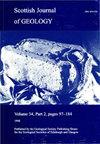New postcranial remains from the Lealt Shale Formation of the Isle of Skye, Scotland, showcase hidden pterosaur diversity in the Middle Jurassic
IF 1.3
4区 地球科学
Q4 GEOLOGY
引用次数: 0
Abstract
The transition between Early to Middle Jurassic was significant in pterosaur evolution, when these volant reptiles exploded in diversity alongside dinosaurs and other animals. It has long been thought, however, that pterosaurs did not develop large wingspans until after the Jurassic, a notion challenged by the recent discovery of Dearc sgiathanach in the Bathonian-aged Lealt Shale Formation of the Isle of Skye, Scotland, whose holotype specimen had an estimated wingspan greater than 2.5 meters. We here report the discovery of a new pterosaur specimen from the Lealt Shale Formation, comprising a tibiotarsus, metatarsal, pedal phalanges, and caudal vertebrae. The elongate tail vertebrae with ossified processes indicate the specimen is a non-pterodactyloid pterosaur, albeit its fragmentary nature makes it difficult to determine whether it belongs to a new taxon. Its metatarsal and caudal vertebrae are considerably larger than corresponding bones in the Dearc holotype, indicating that it belonged to an even larger individual, thus demonstrating that pterosaurs with broad wingspans were not anomalous in the Middle Jurassic. The growing Middle Jurassic pterosaur record of Scotland and England, although mostly represented by isolated and fragmentary fossils, reveals a high diversity of clades, long obscured by the lack of well-preserved skeletons.苏格兰斯凯岛Lealt页岩组的新颅后遗迹展示了侏罗纪中期隐藏的翼龙多样性
早侏罗纪到中侏罗纪之间的过渡在翼龙的进化中意义重大,当时这些volant爬行动物与恐龙和其他动物一起出现了多样性。然而,长期以来人们一直认为,翼龙直到侏罗纪之后才发展出大的翼展,最近在苏格兰斯凯岛巴通尼亚时代的Lealt Shale组发现的Dearc sgiathanach对这一概念提出了质疑,该翼龙的正模标本估计翼展超过2.5米。我们在这里报告了在Lealt Shale组发现的一个新的翼龙标本,包括胫骨、跖骨、脚趾骨和尾椎骨。具有骨化突的细长尾椎骨表明该标本是一种非翼龙类翼龙,尽管其零碎的性质使其难以确定是否属于一个新的分类单元。它的跖骨和尾椎骨比Dearc正模标本中的相应骨骼大得多,这表明它属于一个更大的个体,从而表明翼展较宽的翼龙在侏罗纪中期并不异常。苏格兰和英格兰不断增长的中侏罗纪翼龙记录,尽管主要以孤立和零碎的化石为代表,但揭示了分支的高度多样性,长期以来由于缺乏保存完好的骨骼而被掩盖。
本文章由计算机程序翻译,如有差异,请以英文原文为准。
求助全文
约1分钟内获得全文
求助全文
来源期刊

Scottish Journal of Geology
地学-地质学
CiteScore
1.70
自引率
0.00%
发文量
10
审稿时长
>12 weeks
期刊介绍:
Although published only since 1965, the Scottish Journal of Geology has a long pedigree. It is the joint publication of the Geological Society of Glasgow and the Edinburgh Geological Society, which prior to 1965 published separate Transactions: from 1860 in the case of Glasgow and 1863 for Edinburgh.
Traditionally, the Journal has acted as the focus for papers on all aspects of Scottish geology and its contiguous areas, including the surrounding seas. The publication policy has always been outward looking, with the Editors encouraging review papers and papers on broader aspects of the Earth sciences that cannot be discussed solely in terms of Scottish geology.
The diverse geology of Scotland continues to provide an important natural laboratory for the study of earth sciences; many seminal studies in geology have been carried out on Scottish rocks, and over the years the results of much of this work had been published in the Journal and its predecessors.
The Journal fully deserves its high reputation worldwide and intends to maintain its status in the front rank of publications in the Earth sciences.
 求助内容:
求助内容: 应助结果提醒方式:
应助结果提醒方式:


